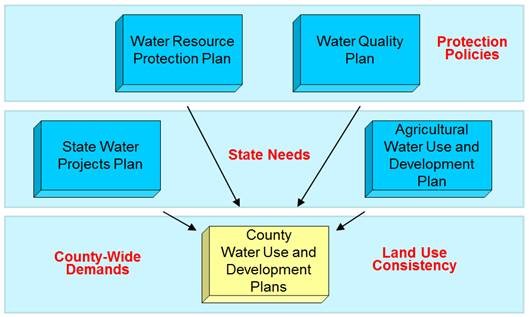Hawaii Water Plan
The State Water Code, Chapter 174C, Hawaii Revised Statutes, recognizes the need for a program of comprehensive water resources planning to address the problems of supply and conservation of water and establishes the Hawaii Water Plan as the guide for implementing this policy.

The Hawaii Water Plan consists of five constituent parts: 1) a Water Resource Protection Plan which is prepared by the Commission on Water Resource Management, 2) a Water Quality Plan which is prepared by the Department of Health, 3) a State Water Projects Plan which is prepared by the Engineering Division of the Department of Land and Natural Resources, 4) an Agricultural Water Use and Development Plan which is prepared by the Department of Agriculture, and 5) Water Use and Development Plans prepared by each separate county.
The Water Resource Protection Plan (WRPP) and the Water Quality Plan (WQP) provide the overall legal and policy framework that guide the development, conservation, and use of water resources. The State Water Projects Plan (SWPP) and Agricultural Water Use and Development Plan (AWUDP) provide information on State and agricultural water needs and development plans. All this information is then integrated into the County Water Use and Development Plans (WUDP), which set forth the broad allocation of land to water use within each county. The following diagram illustrates the integration of the various components of the Hawaii Water Plan. Click on the diagram to view the components of the Hawaii Water Plan.
Hawaii Water Plan Components

In order to provide for effective coordination and long-range planning between state and county agencies, the components of the Hawaii Water Plan must be reviewed and updated on a regular basis. The Hawaii Water Plan was initially adopted in 1990. Recognizing that additional resource and use information was needed, the 1990 adoption by the Commission was conditioned on the submittal of a revised Hawaii Water Plan within one year. However, the 1992 revised draft plans were never adopted. There was general recognition that the components were fragmented and too narrowly focused, that there was inadequate consideration of uncertainties, that tradeoffs were acknowledged, but not addressed, and that projections were made for a single-point future water demand regardless of the physical, environmental or other socioeconomic costs and impacts of the strategies, resulting in a Hawaii Water Plan that was static.
In 2000, the Commission on Water Resource Management adopted the Statewide Framework for Updating the Hawaii Water Plan (Framework). The Framework was developed to provide guidance in the integration of the various components of the Hawaii Water Plan and to give additional direction to the various agencies responsible for the preparation of its constituent parts. The Commission envisions that implementation of the framework will facilitate achievement of public, stakeholder, and agency goals, values, and objectives to protect and manage our most precious resource.
Information below summarizes the objectives and status of each Hawaii Water Plan (HWP) component.
Water Resource Protection Plan
Objective: Protect and sustain statewide ground- and surface-water resources, watersheds, and natural stream environments. Such protection shall be established through a comprehensive study of occurrence, sustainability, conservation, augmentation, and other resource management measures.
State Water Projects Plan
Objective: Provide a framework for planning and implementation of water development programs to meet projected water demands for state projects.
Water Quality Plan
Objective: Protect the public health and sensitive ecological systems by preserving, protecting, restoring and enhancing the quality of ground and surface waters throughout the State.
Agricultural Water Use and Development Plan
Objective: Develop a long-range management plan that assesses state and private agricultural water use, supply, and irrigation water systems.
County Water Use and Development Plans
Objective: Set forth the allocation of water to land use through the development of policies and strategies to guide the County in its planning, management, and development of water resources to meet projected demands.
